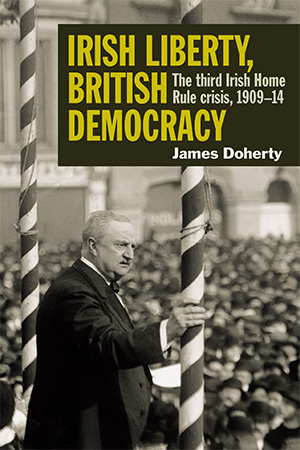IRISH LIBERTY, BRITISH DEMOCRACY: the third Irish Home Rule crisis, 1909–1914
Published in Book Reviews, Book Reviews, Issue 2 (March/April 2020), Reviews, Volume 28JAMES DOHERTY
Cork University Press
€39
ISBN 9781782053606
Reviewed by Martin O’Donoghue
 Martin O’Donoghue is a lecturer in Irish and British history at Northumbria University.
Martin O’Donoghue is a lecturer in Irish and British history at Northumbria University.
In 1935 George Dangerfield published The strange death of Liberal England—an attractive volume that explained the collapse of the Liberal Party in terms of major pre-war factors: the Conservative campaign against the 1911 Parliament Act; the women’s suffrage movement; the rise of labour and trade unionism; and the Ulster crisis. While many later scholars have disputed the thesis of what Peter Clarke called ‘a brilliant impressionistic book’, Dangerfield’s work remains a starting point for many discussions on Liberal decline.
The Irish dimension of this period has been well served by scholars in recent decades. While A.T.Q. Stewart examined the Ulster crisis as early as 1967, more recently Dermot Meleady’s two-volume biography of Irish Parliamentary Party (IPP) leader John Redmond, Ronan Fanning’s Fatal path and works on the IPP by James McConnel and Conor Mulvagh have elucidated the role of Irish politicians in the British context in a period of crisis recently likened to the upheavals at Westminster occasioned by Brexit.
James Doherty’s valuable new monograph, however, provides the first dedicated assessment of Ireland and pre-war Liberalism since Patricia Jalland’s 1980 study The Liberals and Ireland. Doherty argues the case for examining the question within the framework of a British–Irish dispute (p. 9), and the opening chapter offers an intriguing array of ideas mined from an impressive cross-section of Irish and British periodicals and contemporary publications. While the discussion of IPP ideas relies chiefly on the writings of Thomas Kettle (admittedly the movement’s most original thinker), Doherty illustrates well aspects of the party’s position on both sides of the Irish Sea. He highlights how Redmond’s party could fit within a progressive alliance at Westminster, earning him the ‘respect of the adherents of Cobden, Bright and Gladstone’ (p. 42), while being associated with conservatism and the machine politics of the Ancient Order of Hibernians at home.
While Doherty is favourable to the Redmondite cause in respect of partition, he shows that IPP politicians failed to comprehend the strength and seriousness of unionist feeling until a late stage. T.P. O’Connor’s mockery of ‘Ulsteria’ when he told a Cardiff meeting in 1913 that ‘the right way to treat a lunatic was to laugh at him’ (p. 82) jars with a party that would seek to appeal to unionists to secure a unitary Home Rule polity.
Party leaders were more considered in private intercessions and negotiations with other parties, it must be said, and it is the chapters examining Liberal mentalities which remain the strongest in this study. Doherty highlights disjuncture between the grass roots and a front bench which largely shared Tory views on the exclusion of Ulster counties from Home Rule at an early stage. In setting out to demonstrate how Prime Minister Herbert Asquith’s hesitancy in the face of Conservative and Unionist action was out of step with Liberal feeling throughout Britain, this book successfully illustrates how Home Rule came to be seen as part of Liberalism’s role in expanding British democracy.
Chapter 5 on Home Rule in liberal Britain is particularly instructive. Doherty concludes that the National Insurance Act was a bigger factor in 1911 by-elections than Home Rule (p. 141) and that Ireland was (as now) far from the only issue in British politics, however large its shadow. In this sense Doherty’s discussion of Liberal reactions to Redmond’s refusal to support women’s suffrage (pp 145–50) is illuminating, contrasting with Liberal democratising impulses and the ‘warm welcome’ that Irish Home Rule had received from the Women’s Liberal Federation in 1912. As Doherty notes, purchasing Irish Home Rule at the expense of women’s liberty also drew condemnation from Rebecca West in the socialist Clarion. By contrast, unionist action (especially after the Curragh incident) seemed to highlight inequalities before the law, which could be perceived along class lines as well as those of national identity.
The final chapters turn back to nationalism and the ‘impasse’ of 1914. Doherty’s major theses—that Irish Home Rule became a tenet of Liberal conceptions of progressive British democracy, and that partition was not inevitable by the summer of 1914—are brought forth in the conclusion. Doherty devotes more space to the latter point, suggesting Edward Carson’s instinctive opposition to partition, Ulster business leaders’ distaste for rebellion and doubts about the UVF’s training and chain of command as grounds for believing that Ulster unionists might still have accepted a unitary settlement by 1915.
While not all readers may concur on this point, Doherty presents the fullest account yet of Liberal engagement with the Home Rule question in this period. The pre-war Liberal alliance of old Gladstonians—‘collectivist Liberals’ who came to view Home Rule as chiming with their democratising rhetoric and appeal to British working classes—and ‘middle-class leaders’ with conservative sensitivities is probed carefully here. This book can tell us much about the Irish crisis from a British perspective and poses fresh questions about the relative health of Liberal Britain prior to the war. Amidst continued focus on the ‘Decade of Centenaries’, this is a timely study which offers a stimulating re-examination of one of the major imbroglios of Anglo-Irish relations in the twentieth century.
















